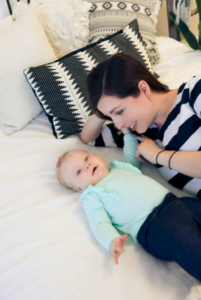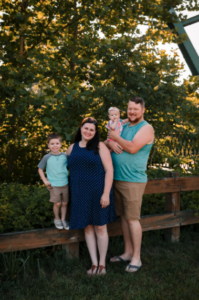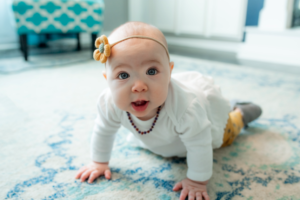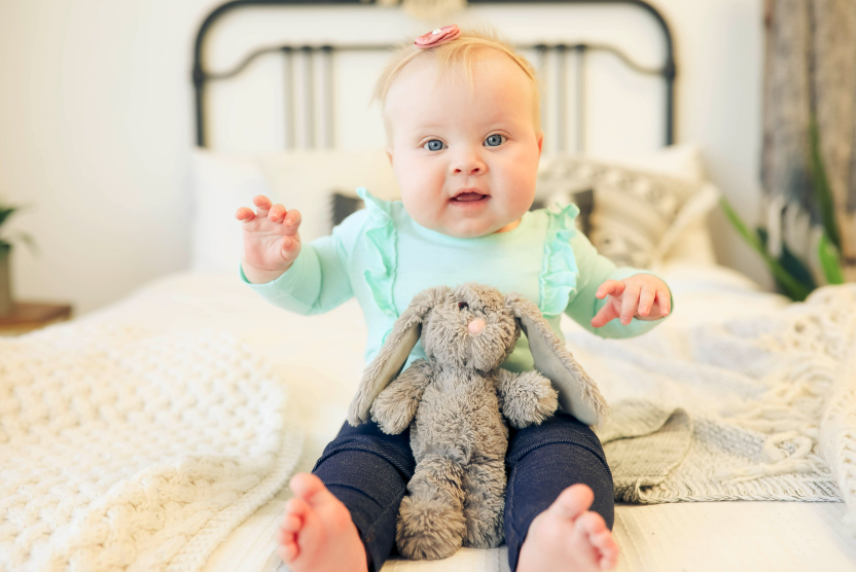Local Moms Discuss Raising a Baby During a Pandemic
Photography Provided by Ellen Joy Photography, Brittney Way Photography & Arrow of Light Photography
 Over a century ago, Joanna Sproull’s great-grandparents lived through the 1918 pandemic. Her grandfather was 3 years old at the time, and now, 103 years later, Sproull and her husband Ben are living in the same Plainfield house, enduring a global pandemic themselves.
Over a century ago, Joanna Sproull’s great-grandparents lived through the 1918 pandemic. Her grandfather was 3 years old at the time, and now, 103 years later, Sproull and her husband Ben are living in the same Plainfield house, enduring a global pandemic themselves.
“When that bit of knowledge hit me, it gave me chills,” says Sproull, who was midway through her pregnancy in mid-March last year when COVID-19 became a reality. Almost immediately, routines began to change. For instance, she was told that her spouse could no longer accompany her to her doctor appointments.
“We felt lucky that we’d just had our 20-week ultrasound right before everything shut down so we got to experience that together,” Sproull says.
Though she specifically asked her obstetrician if she needed to take any special precautions, it was difficult for physicians to know how to advise, given that the virus was so new. Mostly there was talk of flattening the case curve, so as not to overwhelm hospital systems and health care workers. As a result, Sproull began to wonder if she should consult with a childbirth center or look into giving birth at home. An added concern was the fact that she had undergone heart surgery two years prior. The couple had also experienced the heartbreak of miscarriage, so when COVID-19 hit, they felt like they had endured a triple whammy.
Thankfully, everything went smoothly when Maggie entered the world on June 25. Though the couple was overjoyed to welcome their daughter into their family, they admit that parenthood has not been what they imagined it would be. For starters, no one visits.
“She only met seven people in her first six months of life,” Sproull says.
Disappointments started prior to Maggie’s birth, however. The first came when they had to transition Sproull’s baby shower to make it a virtual event.
“Nobody got to see my growing belly,” Sproull says. “In fact, a lot of our neighbors have asked if we adopted because they never saw me pregnant.”
Despite this surreal time, the couple is over the moon with being Maggie’s mom and dad.
“She’s made our world so much better,” Sproull says. “There’s nothing better than this sweet little baby. I’d go through everything 10 million times over just to have her.”
 When Brownsburg mom Kristal Hellmann gave birth to her second child, Bernadette, on January 31, 2020, she and her husband Eric were worried about catching the flu since they had a newborn baby and a 3-year-old asthmatic son.
When Brownsburg mom Kristal Hellmann gave birth to her second child, Bernadette, on January 31, 2020, she and her husband Eric were worried about catching the flu since they had a newborn baby and a 3-year-old asthmatic son.
“Little did we know that halfway through my maternity leave, a global pandemic was going to break out,” Hellmann says.
She admits that in a way, she was sheltered from COVID-19 because she was living under a fog of a newborn.
She vividly recalls the moment pandemic panic set in. It was the end of March in 2020, Bernadette was 2 months old, and it was that time in history when coronavirus coverage was plastered across televisions and computer screens every day.
“Late one night, Bernadette had just given me her first smile followed by a bunch of coos,” Hellmann says. “She made real eye contact with me – not like in the early days when the baby’s looking up and you’re wondering if they’re staring at you or the ceiling fan. It was a nice, peaceful moment.”
Then Hellmann made the mistake of picking up her smartphone.
“I found myself doom-scrolling the internet, reading about how this pandemic is going to last for one to two years – disrupted production cycles, grocery stores not having stock of inventory, and having to wear masks in public,” Hellmann says. “It suddenly hit me, ‘This isn’t going away.’”
During the spring of 2020, as doctors, scientists and other medical experts tried to determine what was safe, ever-evolving protocols made planning difficult. Hellmann recalls stressing because for a brief stretch of time, day cares and pediatrician offices were trying to adjust from previous Indiana state standards to adapt to new COVID-19 rules. Navigating this new world was confusing, as day cares required a doctor’s note for relatively benign symptoms. Meanwhile, pediatricians’ offices were closed as so many weren’t sure how to monitor health and symptoms.
“I felt like I was in this terrible cycle of, ‘My baby can’t get sick because we can’t go to the doctor, yet we can’t go to the doctor to prove my baby’s not sick,’” Hellmann says.
Then there was the worry of missing developmental milestones. While normal milestones include mimicking a smile, facial expression or tone, that’s hard to do when everyone outside the home is wearing masks.
“When Bernadette first started playing peekaboo, it was not in the traditional way with covering the eyes,” Hellmann says. “As soon as she sees me at day care, she takes off my mask and smiles when she sees my face. If that’s not a pandemic baby in a nutshell, I don’t know what is.”
Like many of us, Joyce Martin, a labor and delivery nurse at IU Health West Hospital, struggled – especially in the earlier stages of the pandemic – with having to wear a mask all day at work.
“A smile on my face is comforting and calming, and a way to let my patients know I’m there to provide the best of care,” Martin says. “It’s challenging to communicate with my patients while most of my face is covered. I’ve found eyes also smile, and my patients can hear comfort and calmness in my voice.”
During the pandemic, moms have been deprived of social clubs like breastfeeding support groups, mommy-and-me classes, and play dates, as well as outings with friends and family. Hellmann, who had an annual membership to the Children’s Museum of Indianapolis, had planned on spending much of her maternity leave in the facility’s Playscape area.
“It has those windows where the sun shines in the morning, and that sand table,” she says. “I’d envisioned sitting on one of those nice, cushy benches with my sweet baby while watching my toddler Darwin live his best life at the museum.”
Of course, that didn’t happen.
Though it’s been a wild year, these mommies have nothing but gratitude in their hearts.
“There’s something magical about a 2020 baby,” Hellmann says. “Watching them grow up, there’s that slight terror in the middle of the night when you think, ‘We just had a baby in this world – what are we going to do?’ But then that fades away and you’re left with that extra bit of hope.”
 Avon mom Jaci McGrew gave birth to a daughter named Rosie in July of 2020. The child is McGrew and her husband PJ’s third. McGrew suffers from asthma, so she was terrified of contracting COVID-19 and having pregnancy complications as a result. Thankfully, the birth was smooth sailing. Right after delivery, however, scores of family and friends didn’t flood her hospital room to go gaga over the new bundle of joy, because hospital protocol prohibited it. According to Martin, most moms and dads have not minded this new policy of allowing only one guest into their room.
Avon mom Jaci McGrew gave birth to a daughter named Rosie in July of 2020. The child is McGrew and her husband PJ’s third. McGrew suffers from asthma, so she was terrified of contracting COVID-19 and having pregnancy complications as a result. Thankfully, the birth was smooth sailing. Right after delivery, however, scores of family and friends didn’t flood her hospital room to go gaga over the new bundle of joy, because hospital protocol prohibited it. According to Martin, most moms and dads have not minded this new policy of allowing only one guest into their room.
“New parents say they enjoy the one-on-one time to bond with their newborn baby,” Martin says. “They also feel they have more time for us [nurses] to teach them about newborn and postpartum care.”
Parents who have had babies prior to COVID-19 welcome the one-visitor rule as well because they don’t feel the pressure to entertain a parade of people.
“It’s giving them one-on-one time with their newborn, which quickly changes when they get home with the other siblings,” Martin says.
After the McGrews got home, life continued to feel strange. For starters, not going out and about in public has meant that Rosie has not been exposed to many people. As a result, McGrew feels Rosie has a heightened sense of stranger danger.
“With the older boys, we paraded them and passed them around constantly,” she says. “They got used to people quickly. Rosie hasn’t been able to be in those social situations because we rarely leave the house, and when she does see people out in public, they’re all wearing masks.”
McGrew wonders what that does to her daughter’s developing brain, to see masks in place of bright, smiling faces.
“I’m just thankful for her smile,” she says. “It makes up for not being able to see everyone else’s.”
It’s not just the smiles many of us are craving, but personal interactions as well. McGrew feels particularly bad for grandparents and great-grandparents who have not been able to visit with their families for months.
“Not getting to know and see Rosie, they don’t have the same relationship with my daughter as they do with my older boys,” McGrew says.
Nevertheless, while much has changed, some things remain the same, like the unconditional love and excitement that siblings feel toward the newest little additions to their families. McGrew reports that her sons, Patrick, 10, and Frankie, 6, adore having a little sister.
“They’re so excited to see her when they come home from school,” McGrew says.
The feeling is mutual, as Rosie’s face lights up when she lays eyes on her big brothers.
“It’s been fun watching their own unique relationships with her,” McGrew says. “My 10-year-old is her protector, and my 6-year-old is her playmate. All Frankie wants to do is kiss Rosie.”
It may be a topsy-turvy world right now, with more ups and downs than we’d prefer, but these mommies are not complaining.
“Rosie is everything I didn’t know I needed,” McGrew says. “She completes our family.”





